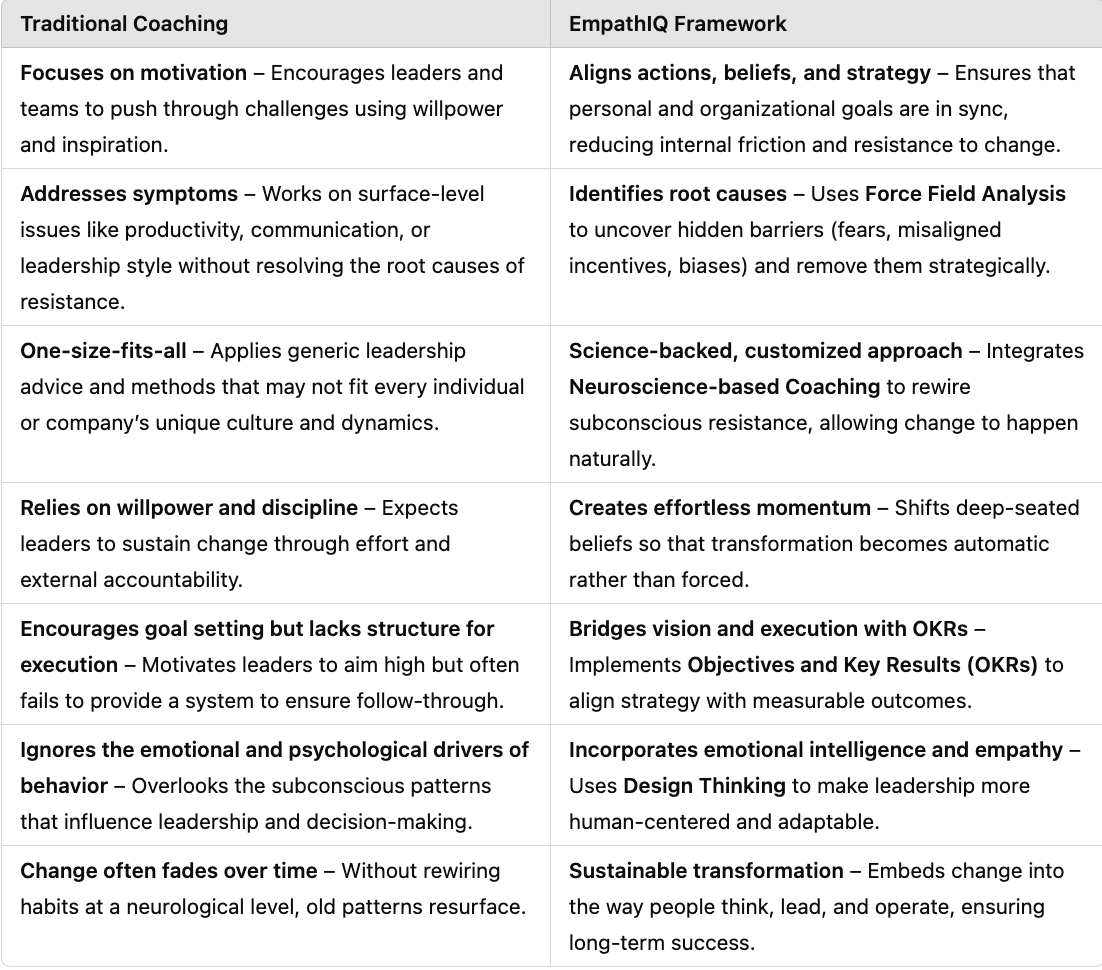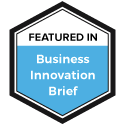The EmpathIQ Framework: A System for Lasting Transformational Impact
Most transformation efforts fail because they treat symptoms instead of systems. The EmpathIQ Framework was built to solve this by rewiring how companies think, organize, and lead.
As organizations face growing complexity, pressure to adopt AI, and the shift toward decentralized structures, true transformation requires more than strategy. It demands cultural readiness, operational clarity, and empowered people. The EmpathIQ Framework is a structured system designed to deliver all three.
What makes the EmpathIQ Framework different is not just the strength of its parts, but how they work together. Design Thinking brings empathy into strategy. Force Field Analysis clears the path. OKRs turn clarity into action. Self-Management unlocks autonomy. Neuroscience-based coaching sustains growth from within. Together, they form a system that transforms how people work and how companies thrive.
The Journey
A few years ago, I ventured out on my own as a Fractional COO, helping organizations scale, align teams, and drive real impact. Along the way, I noticed a recurring challenge, most businesses weren’t struggling due to a lack of strategy or effort. Instead, they were held back by misalignment, internal resistance, and outdated leadership models. I saw brilliant leaders and teams working hard but hitting invisible barriers, doubts, cultural roadblocks, or conflicting priorities that kept them from reaching their full potential.
Most leadership approaches miss the underlying forces that shape behavior, decision-making, and long-term success. That’s where the EmpathIQ Framework comes in by combining:
Business Strategy to set clear goals and execution plans
Human Psychology to shift mindsets and remove internal resistance
Emotional Intelligence & Empathy to create alignment and engagement
Neuroscience to rewire thinking patterns for long-term success
“The EmpathIQ Framework is a structured, science-backed, and multi-faceted approach that integrates key principles to drive sustainable transformation within a unified system.”
Why This Combination Works
When neuroscience, Force Field Analysis, OKRs, and empathy work together, they create an unstoppable force for change. This isn’t just about working harder, it’s about working smarter, with alignment and clarity. Here is how:
Rewiring the Brain for Sustainable Change
People don’t struggle because they lack ambition, they struggle because their subconscious beliefs resist change. Neuroscience-based coaching helps leaders rewire these limiting beliefs, making transformation effortless and lasting.
Identifying Hidden Barriers with Force Field Analysis
Most organizations unknowingly battle against invisible forces, fears, biases, and misaligned incentives. Force Field Analysis makes these obstacles visible so that instead of just pushing harder, leaders can eliminate friction at the source.
Bridging Vision and Execution with OKRs
A powerful vision without execution remains a dream. The EmpathIQ Framework integrates OKRs (Objectives and Key Results) to align teams, set measurable goals, and ensure accountability , bridging the gap between ambition and results.
Empathy as a Competitive Advantage
Leaders who understand how their actions and decisions impact people create trust, engagement, and innovation. Empathy, rooted in Design Thinking, ensures that strategies aren’t just efficient but also human-centered and effective.
The Framework
Before we dive into each component, it’s important to understand that these aren’t standalone ideas , they’re interdependent layers that build on one another. Each one plays a critical role in reshaping how organizations operate, how people lead, and how teams align. Together, they form a cohesive framework that enables transformation from the inside out.
1. Design Thinking: Embedding Empathy into Strategy
The first step toward transformation is learning to see with new eyes. Design Thinking introduces empathy into the strategic process, ensuring that decisions are made with a deep understanding of the people they affect. It’s not about surface-level fixes, it’s about reimagining how value is created by engaging real human needs. For organizations struggling to connect vision with execution, Design Thinking offers the bridge.
Many companies build strategies in isolation, from customer experience, from frontline feedback, and from the real human dynamics that shape success. Design Thinking corrects this by putting empathy at the center of your business decisions.
Design Thinking is not just a creative process; it’s a strategic imperative. It helps companies:
- Reframe challenges through stakeholder lenses
- Facilitate inclusive problem-solving workshops
- Uncover hidden friction in systems, culture, and workflows
When strategy is grounded in human experience, it leads to solutions that stick and cultures that align.
2. Force Field Analysis: Addressing Root Causes, Not Symptoms
Too many change initiatives fail because they treat symptoms instead of identifying what’s really driving or resisting change. Force Field Analysis is the tool we use to uncover these forces and make change sustainable.
This approach helps organizations:
- Understand what’s holding their teams back
- Amplify the forces that support their goals
- Remove friction that blocks performance
It creates a clear, shared picture of what’s really going on beneath the surface, and provides the leverage needed to create lasting results.
3. OKRs: Aligning Action with Purpose
Once clarity is achieved through empathy and force mapping, it’s time to move into coordinated action. Objectives and Key Results (OKRs) transform insight into execution, aligning everyone from leadership to the frontline around shared priorities.
When applied within the EmpathIQ Framework, OKRs:
- Translate vision into tangible outcomes
- Drive cross-functional focus and accountability
- Replace micromanagement with clarity and autonomy
OKRs are not just a measurement tool , they’re a living, breathing framework that keeps strategy aligned with real-time action.
4. Self-Management: Building Cultures of Autonomy and Accountability
Traditional hierarchies can’t keep pace with the speed and complexity of modern business. They slow decision-making, create silos, and suppress innovation. Self-Management offers a scalable alternative.
The EmpathIQ Framework guides organizations to:
- Redesign roles based on purpose, not titles
- Establish decision-making norms rooted in peer accountability
- Foster cultures where people are trusted to lead from wherever they stand
This isn’t about removing structure; it’s about replacing control with coherence and collaboration. Self-managed systems are resilient, human-centered, and built for scale.
5. Neuroscience-Based Coaching: Transforming from the Inside Out
Lasting transformation isn’t just structural, it’s personal. Behavioral change, emotional intelligence, and neural rewiring are all necessary to embed new ways of working.
The coaching, grounded in neuroscience, helps individuals and teams:
- Build emotional agility and reduce reactivity
- Navigate ambiguity and complexity with greater awareness
- Anchor new habits that align with desired outcomes
This component ensures that growth isn’t just about doing more, but about becoming more, as leaders, as collaborators, and as human beings.

Proven Impact
The EmpathIQ Framework has guided scaleups, enterprises, and high-growth companies through periods of transformation, integration, and AI adoption, with measurable success. The results speak for themselves:
- 3x capacity without increasing headcount
- 76% higher employee engagement
- 57% improvement in customer loyalty
Whether you’re navigating M&A integration, AI adoption, or rapid growth, the EmpathIQ Framework gives you the clarity, alignment, and cultural depth to succeed.
Who It’s For
Scaling Startups
Open to transformation and in critical need of frameworks that prevent silos, misalignment, and leadership bottlenecks during growth.
Organizations Adopting AI
AI success depends more on people and processes than technology. These companies need cultural readiness and collaborative operating models to unlock AI’s true value.
Post-Merger or Reorg Leadership Teams
Cultural misalignment is the top reason integrations fail. The framework helps unify teams, values, and operations to turn disruption into cohesion.
Senior Executives
Leaders facing imposter syndrome, decision fatigue, or stalled momentum benefit from neuroscience-backed, mindset-shifting support.
Teams Lacking Psychological Safety
Without trust, performance plateaus. The framework builds the structure, language, and shared accountability needed for open communication and true collaboration.
Conclusion: Beyond Framework, A System for Scalable Humanity
The EmpathIQ Framework isn’t just a framework , it’s a shift in how we lead, collaborate, and grow together. It challenges the old model of command-and-control and offers a proven system for building organizations where purpose drives performance.
In a world that’s demanding more humanity, agility, and clarity, the EmpathIQ Framework meets the moment with a blueprint for structural transformation rooted in empathy.
Ready to Create a Culture that Performs Beyond its Scale?
Let’s explore how the EmpathIQ Framework can help you align teams, eliminate friction, and build a best place to work.

